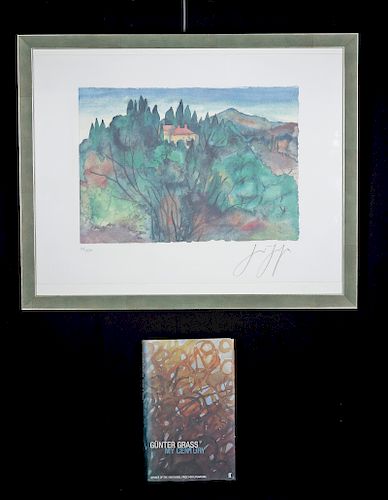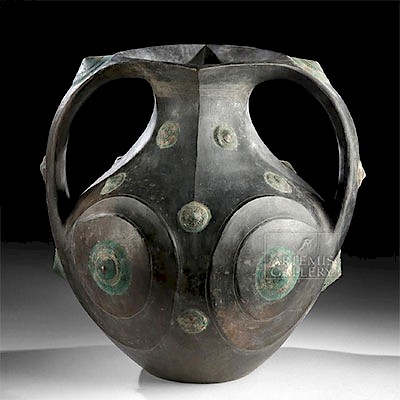Signed & Framed Gunther Grass Lithograph + Book
Lot 208
About Seller
Artemis Gallery
686 S Taylor Ave, Ste 106
Louisville, CO 80027
United States
Selling antiquities, ancient and ethnographic art online since 1993, Artemis Gallery specializes in Classical Antiquities (Egyptian, Greek, Roman, Near Eastern), Asian, Pre-Columbian, African / Tribal / Oceanographic art. Our extensive inventory includes pottery, stone, metal, wood, glass and textil...Read more
Estimate:
$400 - $600
Absentee vs Live bid
Two ways to bid:
- Leave a max absentee bid and the platform will bid on your behalf up to your maximum bid during the live auction.
- Bid live during the auction and your bids will be submitted real-time to the auctioneer.
Bid Increments
| Price | Bid Increment |
|---|---|
| $0 | $25 |
| $300 | $50 |
| $1,000 | $100 |
| $2,000 | $250 |
| $5,000 | $500 |
| $10,000 | $1,000 |
| $20,000 | $2,500 |
| $50,000 | $5,000 |
| $100,000 | $10,000 |
| $200,000 | $20,000 |
About Auction
By Artemis Gallery
Jul 11, 2019
Set Reminder
2019-07-11 10:00:00
2019-07-11 10:00:00
America/New_York
Bidsquare
Bidsquare : Ancient / Ethnographic / Americana
https://www.bidsquare.com/auctions/artemis-gallery/ancient-ethnographic-americana-4246
Discover ancient art from Egypt, Greece, Italy, and the Near East, as well as Asian, Pre-Columbian, Tribal, Fossils and Fine Art. Also featuring a wonderful collection from a prominent New York estate whose owners reside in the Van Wyck family's historic Lloyd Harbor waterfront home. Artemis Gallery info@artemisgallery.com
Discover ancient art from Egypt, Greece, Italy, and the Near East, as well as Asian, Pre-Columbian, Tribal, Fossils and Fine Art. Also featuring a wonderful collection from a prominent New York estate whose owners reside in the Van Wyck family's historic Lloyd Harbor waterfront home. Artemis Gallery info@artemisgallery.com
- Lot Description
Gunter Grass (German, 1927-2015), "Blick in die toskanische Lanschaft II" (View into the Tuscan Countryside) (ca. 2000). Lithograph in colors. Numbered 20/150 in pencil on lower left. Signed in pencil on lower right. A tranquil landscape depicting a red-roofed house on a hill amidst the rolling hills of the Tuscan countryside. Hand-signed and numbered. Professionally framed in a lovely green-painted wood frame behind glass. Label from the Vetter Kunst Galerie on the verso. Also included is Gunter Grass' novel entitled "My Century" (1999) - a collection of interlinked stories that celebrate the 20th century. Size: 9.5" L x 13.5" W (24.1 cm x 34.3 cm); 17.125" L x 21" W (43.5 cm x 53.3 cm) framed
Gunter Grass was a 1999 Nobel Prize winner who was best known for his first novel entitled, "The Tin Drum" (1959). However, in addition to being a writer, Gunter was also an accomplished visual artist who worked in sculpture, drawing, printmaking, and graphic design. "With drawing, I am acutely aware of creating something on a sheet of paper,” Grass told the Paris Review in a 1992 interview. “It is a sensual act, which you cannot say about the act of writing. In fact, I often turn to drawing to recover from the writing."
According to an ArtNews article following his death, Gunter studied sculpture at the Kunstakademie Düsseldorf prior to becoming a writer. Eventually he also became a founding member of Group 47, a literary association whose mission was to "inform the German public about democracy in the wake of the Hitler era". Near the end of his life, he returned to visual art. In the Paris Review, Elizabeth Gaffney wrote, "Günter Grass has achieved a very rare thing in contemporary arts and letters, earning both critical respect and commercial success in every genre and artistic medium he has taken up."
The ArtNews article continues, "Apart from creating his own work, the novelist and artist was also an inspiration to other visual artists. Swiss-German artist Dieter Roth used pages from The Tin Drum in one of his “Literaturewurst” sculptures, which he began creating in the 1960s. The main subject of the famed novel, the young drummer boy, was further referenced by Maurizio Cattelan (see Take a Peek at Art World Prankster Maurizio Cattelan’s Documentary) in his 2003 Untitled sculpture of a young boy playing a drum, which is in the Menil Collection and has been interpreted by some as a call to arms."
Provenance: private Long Island, New York, USA collection
All items legal to buy/sell under U.S. Statute covering cultural patrimony Code 2600, CHAPTER 14, and are guaranteed to be as described or your money back.
A Certificate of Authenticity will accompany all winning bids.
We ship worldwide and handle all shipping in-house for your convenience.
#147441Professionally framed in a lovely green-painted wood frame behind glass. Label from the Vetter Kunst Galerie on the verso. Lithograph has not been examined outside of the frame but appears to be in excellent condition. Wired for suspension.Condition
- Shipping Info
-
All shipping is handled in-house for your convenience. Your invoice from Artemis Gallery will include shipping calculation instructions. If in doubt, please inquire BEFORE bidding for estimated shipping costs for individual items.
-
- Buyer's Premium



 EUR
EUR CAD
CAD AUD
AUD GBP
GBP MXN
MXN HKD
HKD CNY
CNY MYR
MYR SEK
SEK SGD
SGD CHF
CHF THB
THB

















